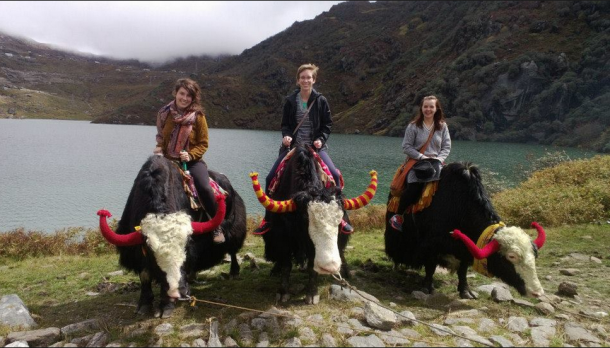Versatile creature of Tibet, Yak.

The Yak is a herd animal found in the mountainous regions of Tibet and Himalaya regions.
- The yak tends to gather in herds from 10 yaks to 100 yaks, most of which are female. There are only a few male yaks per herd. Although there is a large domestic population of yak, there are only a few wild yak remaining . The yak is still used in many parts of Tibet, for pulling heavy farm machines and transporting large loads through the mountain passes。some visitors prefer to ride yaks during their Tibet Tour. The average male yak can grow to about 2 meters tall, with the female yak being about 1/3 the size of the male yak. All yak have very long hair to keep them warm.The yak belongs to the same cow family as the Asian water buffalo, the African buffalo and the American bison. However, the Tibetan yak is slightly more like the American bison in appearance as both the yak and the bison have long hair in order to withstand the colder climates。The yak breeds in the warmer months of September and after a gestation period of nine months the female yak gives birth to a single yak calf. A female yak will occasionally give birth to twins but it is very rare. Some female yak give birth to a calf almost every year but it depends on the environment in which the yak lives and the yak individual. Yak babies are completely independent by the time that they are a year old and they are fully grown when they are between 7 and 8 years old. The average lifespan of a yak is about 20 years in the wild and slightly longer when in captivity. Like other species of cow, the yak is a herbivore and spends a great deal of time on grassy plains in the mountains grazing on grasses, herbs and wild flowers.The yak has firm, dense horns which the yak uses to break through snow in order to get the plants that are buried beneath it and the yak will also use it’s horns in defense. They have long shaggy hair that covers their bodies that keep them warm and dry.
Recent Posts
April 15, 2025tibet
The Ultimate Guide to Tibet Tours, Travel, and Trekking Adventures
April 11, 2025tibet
How to Explore Tibetan Culture
April 3, 2025tibet
Exploring Lhasa:The Heart of Tibet
All Categories
- About Tibet
- book a Tibet tour
- Buddhism Practice
- Budget Tour
- China-Tibet Train
- Customized Tibet tour
- Historical Sites
- Hot Springs in Tibet
- News
- Photography in Tibet
- Tibet attraction
- Tibet Group Visa
- Tibet Motorcycle Tour
- Tibet Small Group Tours
- Tibet Tours and Tibetan Tour Guide
- Tibet Train
- Tibet Travel FAQs
- Tibet Travel Information
- Tibet Travel News
- Tibet Travel Permit Update
- Tibet Travel Prices Rises
- Tibet Trek
- Tibet Trekking Tour
- Tibet weather and climate
- Tibet Wildlife animals
- Tibet Winter Tour
- Tibetan Buddhism
- Tibetan Cultural Features
- Tibetan Culture and Poeple
- Tibetan Festivals
- What to see in Tibet
Tags
book a tibet tour
Chinese visa
Everest Base Camp
Explore Tibet
Himalayan Range
How to obtain Tibet Travel Permit
Lhasa
lhasa tour
Mt.Everest
Mt.Kailash
Mt.Kailash tour
Mt.Kailash trekking
Norbulingka palace
Potala
Responsible Travel in Tibet
Tibet
Tibetan Buddhism
Tibetan Cultural
Tibetan Culture
Tibetan Festivals
Tibetan Losar
Tibetan New Year
Tibetan plateau
Tibetan Prayer Flags
tibet attraction
Tibet EBC
Tibet Group tour
Tibet Old Town
Tibet tour
Tibet tours
Tibet Train
Tibet Train Tour
Tibet Travel
Tibet travel agency
Tibet Travel Guide
Tibet Travel Permit
tibet trekking
tibet trip
Tibet Visa
Tibet Winter Tour
traveling to Tibet
Travel Tibet
Travel to Tibet
trip to tibet
visit Tibet



